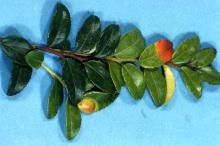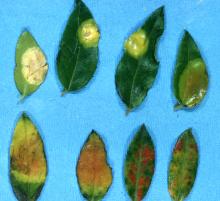See:
Azalea (Rhododendron spp.) - Leaf and Flower Gall
Cause Exobasidium vaccinii, a fungus that is believed to overwinter as spores adhering to bark and bud scales and to cause infection with the opening of buds in spring. Older leaves are resistant to infection. Infection is dependent on high humidity and moisture during bud break. Gall growth is due to plant cell division resulting from the stimulus of hyphal growth within host tissue. When galls are still soft, the fungus grows between epidermal cells, breaks the cuticle, and sporulates. Hosts of this fungus include azalea, Camellia, huckleberry (Vaccinium spp.), Kalmia, kinnikinnick, Leucothoe, madrone, Pieris, Rhododendron and salal.
Symptoms Affected leaf parts become puckered and become reddish-orange. Galls are composed of fungus-infected plant tissue.
Cultural control
- Space plants for good air circulation and to promote drying under wet conditions.
- Remove and destroy galls will help if done before sporulation.
Chemical control No chemicals are specifically registered for this disease on huckleberry; however, the following may be effective.
- Propulse at 13.6 fl oz/A. Do not use within 7 days of harvest. Group 3 + 7 fungicide. 12-hr reentry.
- Quadris Top at 12 to 14 fl oz/A. Do not use within 7 days of harvest or mix with insecticides due to bee toxicity. Group 3 + 11 fungicide. 12-hr reentry.
- QuiltXcel at 14 to 21 fl oz/A. Do not use within 30 days of harvest. Sprayers should not be used on apples. Group 3 + 11 fungicide. 12-hr reentry.
- Tilt at 6 fl oz/A. Do not use within 30 days of harvest. 24-hr reentry.
Reference Sinclair, W.A. and Lyon, H.H. 2005. Diseases of Trees and Shrubs. Ithaca, NY. 2nd edition. Cornell University Press.




